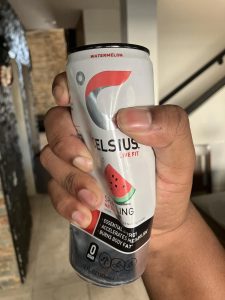OC Sidewalk Vendors Struggle With Costly, Confusing County, City Permits Meant To Help
October 5, 2022
It’s 4:30 a.m. and 19-year-old Víctor Hugo is walking out the door from his home. The sky is dark as he drives 15 minutes to the fruit supplier warehouse in downtown L.A. to pick up the fruit he’ll need for the day. From there, he’ll drive to Fullerton to sell his freshly cut fruit cups. It’s roughly 40 miles round trip and about one hour of traffic each way. This is a daily trip for Víctor Hugo.
He arrives at 7 a.m. to set up his stand and chop the fruit for over an hour as he awaits his first customers, filling a 25-gallon trash bag with scraps. On a good day, Víctor Hugo sells most of his supply. On a bad day, he may have up to a quarter of produce leftover. There are no guarantees in the business of sidewalk vending.
Sidewalk vendors are a common sight in Southern California. However, Víctor Hugo and many other vendors face the threat every day of being shut down, levied with hefty fines, or having all of their food thrown away by code enforcement officials.
In 2018, sidewalk vending was decriminalized in California. The 2018 law reduced the penalties for sidewalk vending from a potential felony charge to a fine. It required every city or county to have a permitting process in place that followed the guidelines of the new law if they wanted to enforce their own vending policies and ticket vendors. The idea was to give vendors a straightforward process toward legalization. However, in the past four years, very few vendors have gotten permits.
On Sept. 23, Gov. Gavin Newsom signed a new bill that would streamline the process of getting a county health permit, which is a huge win for vendor advocates. But it’s not a silver bullet. Vendors will still contend with confusing local and city permitting processes.
Víctor Hugo, who chose not to share his last name, has been shut down for not having a permit on four occasions. Each time his fruit was confiscated, it left him with no ability to make a profit for the rest of the day and little money to purchase fruit for the following day. Víctor Hugo estimates he loses around $2,000 every time it happens. That loss is devastating for the teenager, who left his family in Tehuacán, Mexico, to build up his own business and start a life for himself in the U.S.
According to Matt Geller, CEO of SoCal Mobile Food Vendors Association, that’s common for other vendors, as well.
“I think one of the things that the public should understand is when you’re a vendor and you’re operating with no permit, any time, all your food can get thrown away. Food that you might have prepared for the whole week and all gone in half a second,” Geller said.
Advocates say vendors should have a more straightforward path toward legal status. Other civic leaders argue that these systems are in place to ensure food safety and fair competition with brick-and-mortar businesses. The bottom line is, few permits are being issued, leaving both the vendors and their customers at risk.
The health permit challenge
Advocates say the biggest challenge faced by sidewalk vendors has been the California retail food code – and that’s what the newly signed bill targets. The California retail food code is an extensive document that covers every aspect of selling and serving food in the state of California–it’s what dictates who can get a health permit.
One of the biggest obstacles with obtaining permits is that the laws that apply to sidewalk vendors are the same ones that apply to food trucks, which are much larger than vendor carts and give sidewalk vendors unrealistic policies to follow.
For example, the code requires anyone preparing food to have three sinks. This requirement makes sense for a food truck that is washing dishes all day long. Vendor advocates say that’s excessive for someone like Victor Hugo who is only cutting fruit with one cutting board and one knife.
Beverly Estrada, a tamale vendor in the Los Angeles area and owner of At Bev’s Tamale’s, has also faced health department challenges: “The health department… if they don’t like that refrigerator, they tell you, change it to a commercial refrigerator and come back. If you take the refrigerator and they don’t like that the water is not coming out from that pipe, then you have to change that pipe and then go back. If you go back with the refrigerator and the pipe fixed and then they don’t like the burners are not turning on correctly, you have to go and change the burners and come back. So it’s a really, really hard process.”
A new bill backed by a coalition of vendor advocates, SB 972, will streamline the process of getting a health permit for sidewalk vendors. It was passed in August 2022 by the state senate and assembly and signed by Gov. Newsom on Sept. 23.
“We want to make sure that they are within health and safety guidelines in an appropriate way, but also not being subjected to the requirements of something like a food truck, which is a much larger operation,” Kelkar said.
In Los Angeles County, one company didn’t wait for the California retail food code to be updated and has found a workaround to help vendors get their health permits. Revolution Carts is a food cart company that sells carts that have been approved by the L.A. County Department of Public Health, meaning they pass the California retail health code. The carts, called tamaleros, were designed and engineered by Richard Gomez. They provide a solution for tamale sidewalk vendors looking to fast track at least one part of the permitting processes.
Estrada was one of five vendors who received a cart as part of a collaboration between Revolution Carts and Rockstar Energy Drink in February 2022. Beverly was approached by Revolution Carts over social media. It was a welcomed collaboration, since she has struggled to get a health permit since starting her business 12 years ago.
How many sidewalk vendors are permitted in Orange County
In most parts of the state, vendors need to get both a health permit from the county as well as a street vending permit from the city. Each city has different criteria and application processes.
Fullerton has 39 mobile food facility permits that have been issued by the Orange County Health Care Agency, as of May 2022, and all are ice cream businesses registered to a single address on Lemon Street. Fullerton has issued no sidewalk vendor permits since its permitting process took effect in 2020.
According to data obtained from the Orange County Health Care Agency in March 2022, Placentia has two mobile food facility permits; Tustin has three, two of which belong to the Tustin Ranch Golf Club; Garden Grove has seven, most of which are registered to the same address. Buena Park has 27, of which 26 belong to Knott’s Berry Farm. As for Yorba Linda, Orange, Cypress, La Habra, and Brea: it’s zero.
Two larger Orange County cities have higher numbers: Anaheim and Santa Ana. Anaheim has 382 mobile food facility permits – or county health permits – but 165 of those belong to Disneyland and its properties. These health permits cover everything from an elote cart to a taco truck. However, sidewalk vendors would also need to get a vending permit from the city of Anaheim, on top of the health permit from Orange County. As of March 2022, the city of Anaheim has issued no permits to sidewalk vendors, according to Mike Lyster, chief communications officer for the city of Anaheim.
Santa Ana has 748 mobile health permits, by far the most in Orange County. The city requires sidewalk vendors to have a business license or a peddler’s permit, on top of the county mobile food facility permit. Only 40 businesses in the city of Santa Ana have a peddler’s permit, a push cart peddler’s permit, or a “miscellaneous” vending permit, according to a list of all city business licenses as of March 2022.
The barriers to getting a permit
Advocates argue that the numbers of permitted vendors are low in most Orange County cities because the steps to getting a permit can be prohibitively expensive and time consuming.
For example, in order to get a vending permit in Fullerton, vendors must first go to the police department to have fingerprints taken, then contact the fire department for a class K fire extinguisher which is used in cooking areas, provide proof of a seller’s permit, proof of a fictitious business name, proof of commercial general liability insurance, recent photos of the employees, and the Orange County Health Care Agency permit.
Many cities require sidewalk vendors to carry a million dollars in liability insurance.
Lyric Kelkar is the policy director for Inclusive Action for the City, a group that advocates for street vendors. She says the liability insurance is an unnecessary step in the permitting process.
“We don’t think that it makes a ton of sense for sidewalk vendors to have liability insurance because they aren’t a brick-and-mortar business,” Kelkar said. “If someone trips on the sidewalk in front of them, that’s the sidewalk, it’s a public right of way.”
Kelkar’s group and others have been trying to change some of these requirements over time. The 2018 law, known as the Safe Sidewalk Vending Act, or SB 946, stipulates that cities can only regulate when and where street vendors set up shop based on health and safety concerns.
But a 2021 UC Davis study found that over three-quarters of the cities and counties in the state “include street food-vending regulations that go beyond public health rationale and include labor laws and restrictions on time and hours of operation.”
Lyster, the spokesperson for the city of Anaheim, said these regulations are important to protect pedestrians and support local brick-and-mortar businesses. “Street vendors often force passersby and their own customers into streets,” Lyster said in an email. “That is never acceptable, but it is extremely dangerous in the Anaheim Resort where there are thousands of pedestrians walking alongside the major thoroughfares.”
Lyster told Voice of OC in August 2022 that the city plans to crack down more on organized street vendor operations, which he says exploit immigrant labor.
According to the UC Davis study, sidewalk vendors increase the overall vitality of an area by bringing in revenue and providing affordable and culturally relevant food. Still, many cities in California have implemented regulations on sidewalk vendors in commercial areas. In Anaheim, the area around Disneyland is restricted to vendors due to health and safety concerns, according to Lyster. In Fullerton, it’s the area around downtown. In Tustin and Orange, it’s their rescpective Old Towns.
Kelkar questions whether those restrictions comply with the law. “We’re unsure about the validity of health, safety and welfare concerns in places like no vending zones,” Kelker said.
A proxy for immigration law
The push to pass The Safe Sidewalk Vending Act in 2018 coincided with growing fears of deportation and harassment among undocumented immigrants, many of whom make a living selling food or other items independently. That’s why the law decriminalized vending, so local police would have less of a reason to interact with vendors.
“You shouldn’t be allowed to use something like enforcement of the ability to sell food as a proxy for immigration law,” said State Sen. Josh Newman, who represents a portion of Southern California which spans cities from Chino Hills to Cypress.
Although vendors can now only be charged with a misdemeanor, not a felony, for not having a permit, under the 2018 law, there are still restrictions in local ordinances that deter immigrants from getting permits.
In Fullerton, the first step in the process requires vendors to visit the police station. That can be a major obstacle for vendors who are undocumented.
“A lot of our street vendors are illegal. A lot of them, that’s their lifeline. And if they don’t have that lifeline no more, they’re not able to provide for their families,” said Estrada, the Los Angeles tamale vendor.
Bringing an underground economy above ground
Kelkar hopes that, with more education and investment from local governments, there will be more solutions to vendors getting legal status.
“This is turning the informal economy into a formal one,” Kelkar said. “This requires investment upfront from the jurisdictions to make sure that the vendors have what they need instead of creating barriers and bureaucratic processes that will ultimately deter them.”
Advocates argue that by giving vendors a path towards legitimacy, it also means the public can have more confidence in food safety and also boost local economies.
“Having a permit protects them and allows them to help build their business,” said Geller, the head of the SoCal Mobile Food Vendors Association. “They might not want to just serve tamales out of a trunk. They might want to have one cart, two carts, ten carts. They might want to have a restaurant or a food truck.”
That’s certainly the case for Víctor Hugo.
“This business has helped me move forward and afford things that I could not before,” he said. “It’s a process that has cost me, but you know people say at the end the reward is big. With dedication and work, I got this where it is.”
This story was co-published by Voice of OC. Jessica Langlois was editorial adviser; Jessica Q. Chen was video consultant. Mariana Escoto was fixer and translator; Gerardo Chagolla provided additional translation support.
This project was supported by funding from California Humanities Emerging Journalist Fellowship Program. Any views or findings in this story do not necessarily represent those of California Humanities, the National Endowment for Humanities, or Fullerton College.

















